March 27, 2005
Genres Hamper Mobile Internet
A Reuters article made the rounds 10 days ago -- "Web pioneer: Design hampers mobile internet." In it, Tim Berners-Lee decries, "Everyone was supposed to be browsing the Web with their mobile phone, but the problem is that it has not happened."
I've long been frustrated by how people seem to think that content is this formless mass that you can pour into different devices, like water into different glasses. And my thinking around document genres lead me to begin articulating a framework for thinking about content in different devices, as a way to better understand why we're not "browsing the Web with [our] mobile phone[s]."
Document genres are about how form and content come together to address a purpose. In doing so, the rely on our expectations for how that genres is designed in order to facilitate its use. When I open the envelope with my credit card bill, I don't expect a comma-delimited list of purchases in alphabetical order. I expect a tabular list of purchases, in date order. I expect that the first page will summarize my purchases for the period, and provide a space for me to write in how much I plan to pay.
As credit card bills move to the Web, it's important to recognize that, while serving a similar purpose, and having similar content, the fact that it is on the Web means it's a materially different (though related) genre. I bring different expectations to how I utilize a credit card bill on the web, such as: you don't flip through pages finding certain information, you utilize links which allow access to information chunks; the ability to call up payment history from before the period in question; etc.
In the same way that paper-based document genres evolve when they're brought to the web, digital document genres rely on the various devices within which they're viewed. And you can't just take any web page, and expect it to work within any device (remember WAP?).
So, I've started thinking about understanding what genres work best in what devices, and why. It begins by thinking about content-related attributes of different devices.
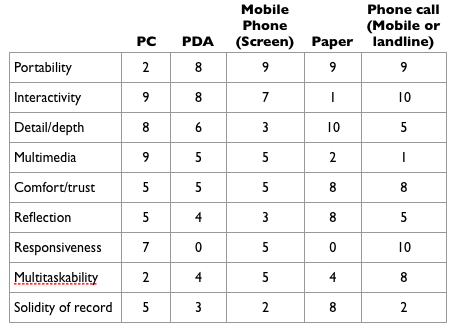
Some terminology clarification:
Portability - the ability to carry it around
Interactivity - the ability for the device to provide instant feedback to a user's action
Detail/depth - the amount of resolution and detail the device provides
Multimedia - the ability to utilize more than one medium at a time
Comfort/trust - generally, how comfortable and trustworthy people find a device
Reflection - the degree to which a device engenders a user to reflect on the content within. A distinction borrowed from Ellen Lupton in her essay, "The Birth of the User."
Responsiveness - the ability, for when something goes wrong, to get an immediate response that can address the situation.
Multitaskability - the ability to do other things while engaging with the device
Solidity of record -- the degree to which you can rely on the device to maintain a record of action
I graded each device on a scale of 1-10, 10 being best/highest.
When thinking about genres, the concept of "purpose" gets foregrounded. And when thinking of purpose, of the task at hand that someone is trying to accomplish, we realize that purposes/tasks require an appropriate degree of these attributes.
Let's take the long and involved process of buying a house. Looking at some steps along the way, we can get a sense of what tasks require what attributes... And what that says about where document genres are best suited.
So, when you're choosing houses to check out, that task has certain attribute requirements.
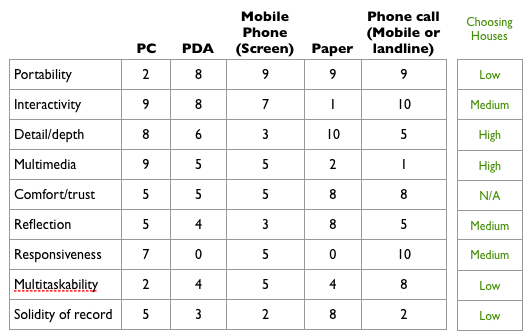
You don't want to waste your time visiting a house that's not suited to you, so what's most important is to get a lot of information, and information that *shows* you the house -- photos, videos, QuickTime VR. As you rank the importance of each attribute for the task, and then look across the table, you realize that PCs are exceedingly well-suited to helping people choose houses. It shows why we've gone so quickly from super-brief classified ads to media-rich web pages in a very short time.
How about much later in the process, when you're applying for a mortgage?
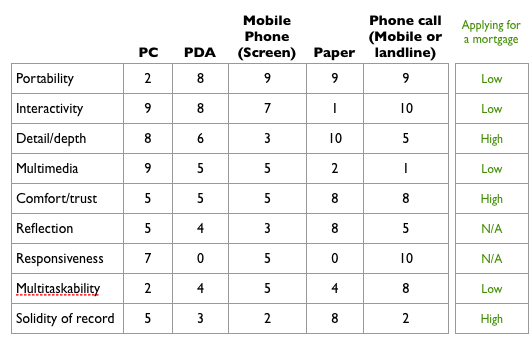
The chart suggests why applying for mortgages is still largely rooted in the world of paper -- the crucial elements of comfort/trust and solidity of record. But those are cultural attributes... and you can see that PCs are not all that far behind, and those numbers will doubtless rise over time.
That's enough of this for now. In time I'd love to figure out a way to make this more rigorous, and come up with some methods for taking advantage of this.
March 22, 2005
Enterprise Search Report Review
Tucked away in Adaptive Path's latest newsletter is Chiara Fox's review of "The Enterprise Search Report: Requirements, Costs, Products, and Practices." Chiara gives the report high marks, which is good, since the report costs $1,350.
March 21, 2005
Adaptive Path Celebrates, March 24
As is written on the company website:
In honor of our fourth anniversary, and as an office warming for our new space, we’re having a party. All are welcome — stop by, meet the team, have a drink. Thursday, March 24, 5:30 p.m., Adaptive Path World Headquarters, 363 Brannan St., between 2nd and 3rd.
Please RSVP
Is "User Experience", for all intents and purposes, dead?
Reading the notes from a recent panel on UX disciplines, and remembering the notes from an earlier, similar, panel, I am left with the thought that the phrase "user experience," as a meaningful term describing practice and concern, is dead.
Dead dead dead.
Which is disconcerting, since my company has all but bet the farm on the concept.
The reason I say, "dead" is because my experience in reading the goings-on of these panels is one of self-flagellation. I feel obliged to keep up with these things, but the degree to which the discussion is an exercise in semantics, territoriality, inaccuracy, and pointlessness, suggests that if I'm a willing reader, I must be a masochist.
Over six years ago, I began describing my efforts as "design[ing] 'User Experience.'" I'm wary of that now.
The organizations that attempt to claim it (UXNet, BayDUX) have only done an extreme disservice by rendering the term irrelevant.
(And don't get me started on DUX2005... the conference is only a little more than 7 months out, and there's pretty much no substantial word about it anywhere. Take *that*!, "user experience community"!)
"User experience" feels like a term, and concept, whose meaningful time is over. I don't know what (if anything) will take its place. But there's clearly a lack of interest and effort in meaningful evolution. The energy seems to be behind the terms and concepts of "information architecture," "interaction design," and "usability engineering." Maybe we should take that as a sign.
March 19, 2005
Wordsmith Hipsters
Over three years ago, I wrote about seeing Erin McKean, lexicographess extraordinaire, speak at a local bookstore.
Well, reading the NY Times today, I see that she's now editor-in-chief of the Oxford American Dictionary. At 33! And still very crush-worthy. Anyway, a decent article on how young'uns are storming the castle of words.
Folksonomy Talks: Information Architects Surpass Techies
Yes, I'm biased, but, based on the notes I'm reading about the folksonomy discussion at ETech, the IA Summit panel on Social Classification was a far richer and more robust discussion (note: I was on the IA Summit panel).
The etech discussion didn't really get beyond what you can read on blogs.
The IA Summit discussion had delightful grenades lobbed by Peter Morville(PDF), and a good question and answer, where we actually bothered to be critical of folksonomies (discussing how many women with social science backgrounds (Shelley, Liz, Danah) have taken strong issue with the folksonomy-utopianism of all the young white guys), talk meaningfully about extending them (integrating them with other modes of classification), and recognize the visceral poetry of free-tagging (it's all about me).
It's worth noting that the folksonomy discussion emerged from the information architecture community -- a group of people obsessed with issues of structure, shape, accessibility, meaning, utility, and other facets of information. Folksonomies aren't interesting from an "emerging technology" perspective -- they're interesting from a social and cultural perspective. And it seems that Etech is lacking that breadth in perspective in spades.
March 18, 2005
Lev Manovich Lecture: Software > Culture
I'm attending a lecture given by New Media scholar Lev Manovich. He's perhaps best known for his book, The Language of New Media.
Notes:
- the man introducing lev just used the word "interpenetration"
- lev's "powerpoint" is just a text file... which he uses because ideas come to him in his lectures, and he wants to be able to capture them
- connectivity as a response to modernity ... modernity fractured culture/society, connectivity brings it back together
- talking about his projects... in trying to figure out connecting themes, he decided to use "software" and "culture"
- the culture of software is here, it's not just equally distributed
- in order to invent new media, in order to invent alternatives to the mainstream/commercial formats, new media artists and programmers need all the help they can get
- need help from the humanities to understand cultural forms
- new media texts often didn't directly refer to "software", so he and a colleague decided to put software on the agenda
- for academics, the concept of software as a cultural force is still invisible
- you can't understand "new media," "internet," etc., if you don't address software - he's developed a DVD on "soft cinema"
- large commercial websites portray/utilize culture in a way that's software-driven... algorithms determining what content is shown to you
- overlapping windows have become an essential quality of our visual culture
- he steps through these four concepts of form:
1. "Algorithmic Cinema." Using a script and a system of rules defined by the authors, the software controls the screen layout, the number of windows and their content. The authors can choose to exercise minimal control leaving most choices to the software; alternatively they can specify exactly what the viewer will see in a particular moment in time. Regardless, since the actual editing is performed in real time by the program, the movies can run infinitely without ever exactly repeating the same edits.
2. "Macro-cinema." If a computer user employs windows of different proportions and sizes, why not adopt the similar aesthetics for cinema?
3. "Multimedia cinema." In Soft Cinema, video is used as only one type of representation among others: 2D animation, motion graphics, 3D scenes, diagrams, maps, etc.
4. "Database Cinema." The media elements are selected from a large database to construct a potentially unlimited number of different narrative films, or different versions of the same film. We also approach database as a new representational form in its own right. Accordingly, we investigate different ways to visualise Soft Cinema databases.
- using principles to generate aesthetics across different media, and in different contexts
- we see some clips from the soft cinema dvd... in particular, a bit about a woman who loves going through auto car washes
- lev seems very much in the russian constructivist tradition. the video he is showing reminds me of jessica helfand's essay, "De Stijl, New Media, and the Lessons of Geometry".
- he now talks about the new journal Version (the website is a series of massive jpegs. blech.)
- now talking info-aesthetics, the relationship between information and form in contemporary society
- 1. you could start with: we don't need radically new forms, software allows us to reconfigure existing media in new ways
- 2. but that's not really satisfactory (missed why)
- 3. how do people in different fields use computers and software to translate information to new forms that humans can receive and comprehend
- get beyond the old media/new media dichotomy; include bits and atoms, design, industrial design, architecture, etc.; see the tension in the translation of information into form and how it's drives aesthetics in the new media landscape.
Q&A
q. the lineage of constructivist, the aesthetic from the earlier 20th century, as opposed to art nouveau -- why is that the dominant layout convention?
a. a key logic driving modernity is the logic of efficiency. 1860-1940, engineer is an expert in efficiency. the aesthetics that emerged (bauhaus, constructivists, etc.) at that time were also driven by efficiency. you can use taylorism to make production efficient. minimum material for maximum effect --> minimalism.
what's the notion of efficiency in information culture.
compares OS 9 and OS X.
in OS 9, the interface is supposed to disappear.
In OS X, the interface itself is aestheticized, a baroque aesthetic experience. It's not longer about efficiency... it's about experience... experience design and other things.
the only way to build big-scale systems is to have lots of processes... that talk to each other... it's not efficient, but the system develops an emergence...
q. if new and old media is the wrong dichotomy, what do we call ourselves? we're the center of "new media."
a. well, we must be practical. around the world "new media" is understood. i'm not saying the dichotomy doesn't make sense, i'm just trying to get beyond it. the most interesting work is not in strictly new media, but where new media intersects other fields, like architecture.
other questions were asked, but it got too esoteric even for me.
March 15, 2005
Applications as Digital Document Genres
A convergence of some thoughts here at peterme.
First off, there's document genres. Genres are "a distinctive type of communicative action, characterized by a socially recognized communicative purpose and common aspects of form."* One way to think about documents is that they are tools for managing information and communication. We use our understanding of genre to help us identify documents that will aid us in addressing a task we're trying to accomplish. If I'm trying to figure out how to get from where I live to where I want to go, I'll utilize a "map" genre, and look for documents whose form suggests I'll find cartographic content.
Then there's Jotspot, a service for cobbling together simple applications, which I recently discussed. If you look in their application gallery, you'll see applications which have a genre-like feel, where you know what to expect before you even use it: RSS Feed Aggregator, Company Directory, Bug Tracker, Blog tool, such as Simple Poll.
And then Jess over a ia/ wrote about Microsoft's development of "application archetypes" in an effort to help developers put together software that people will get.
It's interesting to think of the evolution of digital document genres involving software, and it only makes sense. Physical document genres help me understand information, and, in the case of things like ledgers or forms, even manipulate information in rudimentary ways. The first digital document genres have largely been electronic versions of the old paper-based ones, but some, like the spreadsheet, demonstrated what happens when you add interactivity. If tools like blogs, wiki, and things like Jotspot succeed, they'll put in ever-increasing hands the ability to manipulate information to accomplish tasks... and with that, new genres will emerge as responses to those purposes.
* Yates, J., & Orlikowski, W. J. (1992). Genres of organizational communication: Astructurational approach to studying communications and media. Academy of Management Review, 17(2), 299-326.
March 14, 2005
Using Document Genres - Good and Bad
One of the things that's essential about genres is how they communicate what you would use them for. Genres are all about setting expectations for content, which is essential when you're trying to accomplish something, and need certain kinds of information to do so.
Genres on the Web must be painfully clear, since we don't have the physical cues to suggest what you will get. This means that links must be explicit. (This all relates to my notions of explicit design... I'm ditching that term, though don't currently have anything in its place.)
Here's a page that intelligently takes advantage of our understanding of genre:

The links down the right hand side use clear genre-related terms like "features," "system requirements," and "datasheet." You have a good sense of what to expect before you click it. It's also well presented -- easy to scan, easy to find exactly what you want to click into.
Compare that page with a competitor's page for a very similar product (I've "zoomed in" on the side bar):
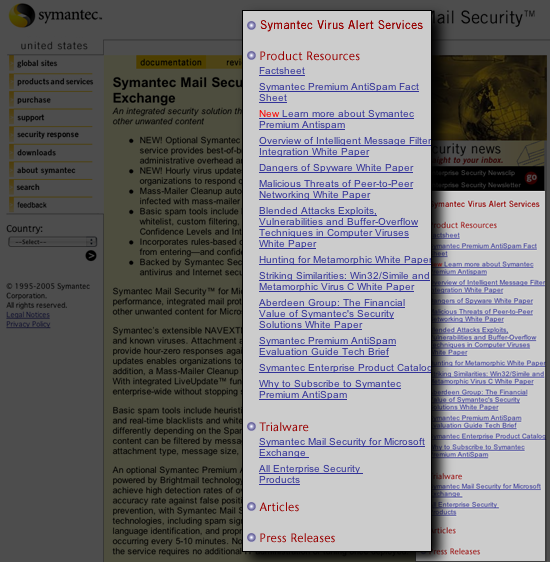
Here, genre is not well-used. Yes, a bunch are "white papers," which is a pretty well-understood genre... But you have to read these long links before you understand which genre it is. Also, what's a "factsheet"? What's a "tech brief"? And, "Articles?" Could a genre label be more vague?
Trend Micro's page gives the user confidence. Symantec's page will only leave a lot of doubt. And it's all because of genre.
I also find genre interesting in terms of how it allows an audience to self-segment. One of the challenges of web design is presenting the right content to the right people. If you're selling something technical, you want benefits-oriented content for the business owners, overview content for managers, and technical content for the IT types. But you don't want direct people by role, because a business person might also be an IT person. Smart use of genres allow visitors to self-select based on their current task at hand. You don't have to worry about role.
March 13, 2005
There's Plenty of Room at the Bottom*
Over two years ago, I attended the Supernova conference, and wrote about a panel I saw on collaborative business. The gist of the panel was that monolithic tools to support collaboration don't work, and that what does work are smaller, more pointed task tools such as email and IM.
Then, just this morning, I read Joe Kraus' post about "the long tail of software", where he explains why he believes there's a huge opportunity in giving people the ability to create simple software tools that adapt to their specific organizational processes. He believes he can horn in on the email+Excel space that runs most small companies today.
Given what I wrote over two years ago, I think there's a lot of potential promise in Joe's post. Joe has a new company Jotspot, which aims to execute on that vision. There's definitely a certain amount of appeal to Jotspot's provision of tools to solve business processes, or to allow you to cobble together a solution on your own.
For a project I just completed, I interviewed 11 people in small and medium-size businesses who currently use Excel and email to run a fundamental aspect of their business (can't say what, specifically). And Joe is going to have a host of difficulties in getting people like the ones I spoke to to adopt a system such as his...
- it's called a "wiki" -- folks in middle management who "own" the spreadsheets in their group don't know what wikis are, and don't want to
- it requires learning yet another new thing -- folks in middle management who "own" the spreadsheets are swamped in their day-to-day responsibilities and i think the idea of learning a whole new markup language would be a strong deterrent
However, Joe has an interesting advantage which is that Jotspot feels "small." It feels like something any individual can adopt and play around with, and not necessarily need some form of approval. Particularly because it's all through the Web -- no need to install software on the company PC and all the hassle associated with that.
It'll be interesting to see where this all heads...
* The title of Richard Feynman's seminal talk that spurred the creation of nanotechnology. Seems appropriate.
March 11, 2005
Pissing Off Librarians: My Talk on Document Genres
I plan, some day, to discuss my thoughts/research/practice involving document genre in great detail.
For now, I'm offering for download the PDF of my presentation at the IA Summit 2005.
Document Genres: The Hidden Workhorse of Information Architecture.
I just wrote a little thing to a mailing list which might provide some context:
For those who missed my talk at the IA Summit, I spoke (at some length, and awfully rapidly) about document genres as an overlooked element in the standard practice of information architecture.By genre, I'm referring to things like
- press release
- map
- home page
- weblog
- feature listAny type of document that has been developed to serve some specific purpose (usually the accomplishing of a task) and for which has emerged a fairly stable form.
So, in this case, even though all that PDF says is "chicken," when you look at it, you know it's utilizing our understanding of the "academic paper" genre. The genre has such a well-developed form that it's obvious in the blink of an eye.
In my talk, I discuss how genre is woefully underused in an explicit fashion. Genre is essential in helping people set expectations for 1) information and 2) use of that document, and while we have very many explicit affordances for such things in "the real world," online all we usually have is a link... So those links need to be explicit, and often explicit about the genre of what is to come, so people can make reasonable predictions of what to expect when clicked.
One thing I've heard since I've returned to SF is that I "pissed off librarians" with my talk, because I am only just repackaging what they've known all along, so what's the big deal? And who am I to take credit?
The big deal is--why aren't they talking about this with information architects? Why is genre never discussed on any website project I'm working on?
I'd be more than happy to make a career out of taking the wisdom from library and information science, and bringing it to the web design masses... Whether its faceted classifications or genres, someone's got to spread the word.
If you're interested in pursuing digital document genres further, in ways that seem to me highly relevant to information architecture, the single best resource is Prof. Kevin Crowston's papers.
March 03, 2005
Design and Strategy: Nobody Knows Anything
Yesterday afternoon I attended the Institute of Design's Strategy Workshop. It was their first attempt at trying to bring their design+strategy message to people outside of Chicago. They had expected about 30 people to register. They sold out at 100, and who knows how many more would have come.
The top draw was probably the panelists--Rob Forbes from Design Within Reach, Bill Hill from MetaDesign, Clement Mok, and Peter Coughlan from IDEO. These are some pretty heavy hitters, and $100 bucks isn't a lot to get some wisdom from them.
I didn't take any notes until Clement spoke, which was too bad, because before him, Rob and Bill spoke. Rob mostly talked about how he considers the operational development of his retail business a case study in design -- fair enough, but not all that meaningful to me. Bill, well, I can't remember what he talked about. I just remember thinking, "Wow. Meta is a dinosaur. They're still coasting on laurels earned in the 80s. What have they done for me recently?" I mean, they're still an excellent graphic design shop, but it's not clear that they are much more than that. They're definitely *not* advancing the dialogue in any meaningful way.
 Clement talked about his experience as president of AIGA and, more recently, his return to Sapient in trying to help them put together a(nother) design practice. Clement, being Clement, thinks in models, and presented two.
Clement talked about his experience as president of AIGA and, more recently, his return to Sapient in trying to help them put together a(nother) design practice. Clement, being Clement, thinks in models, and presented two.
The first was a 2x2 of what design can impact and what folks are interested in...
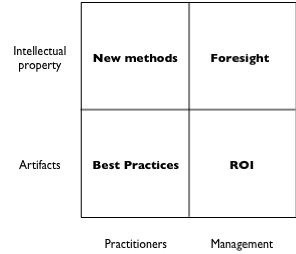
So, when it comes to artifacts, practitioners are about best practices, and management is about ROI. And when it comes to intellectual property, and other intangible value, practitioners are developing new methods, while managers are seeking foresight.
And the thing is, the process of design is kind of this shapeless mass that touches all of these things...
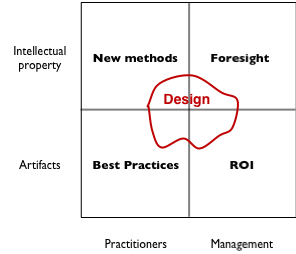
And Clement feels that the messiness of design is frustrating for folks, and there is an opportunity for bringing clarity to the process.
Clement's second model was even more obtuse...
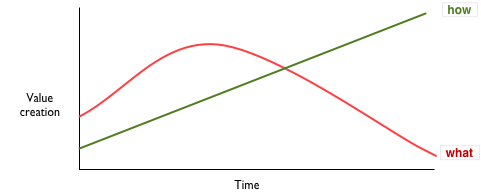
If I understand it correctly, Clement is simply saying that design adds greater value in the long term by being applied to the HOW of business (practices and process), whereas being applied to the WHAT of business (products) ends up having limited value as those products become commoditized.
I don't know if I share Clement's perspective, but there it is.
 Peter Coughlan discussed his work heading up the transformation practice at IDEO, where, basically, companies come to learn how to be innovative, the IDEO way. It's all about designing business. They lead them through rapid processes, breaking down organizational silos, towards developing products, and then ask them -- okay, what will it take for you guys to get there?
Peter Coughlan discussed his work heading up the transformation practice at IDEO, where, basically, companies come to learn how to be innovative, the IDEO way. It's all about designing business. They lead them through rapid processes, breaking down organizational silos, towards developing products, and then ask them -- okay, what will it take for you guys to get there?
Peter talked a lot about co-creation with the client... How the model has shifted away from designers being given requirements, going away for three months, and returning with The Solution, and toward having clients and designers working together to solve problems. (This was gratifying to hear, if only because this is what we've been doing at Adaptive Path for 4 years...)
Peter identified three stages in working with companies to behave innovatively:
1st Stage: Proof of process
It takes companies a while to "trust the process," particularly because IDEO's process seems so simple.
2nd Stage: Checking what worked, what didn't
Throughout the process, you take good notes, figure out where the shortcomings were, and correct from there.
3rd Stage: Figure out how to replicate
Once you're fairly confident you've figured out how to be innovative within this org, you replicate it throughout the company.
The challenges Peter outlined in getting this to work included:
- Fear of open-ended process
Clients want to KNOW what the results will be. Which, of course, goes against a truly exploratory process. Or they're afraid that the process will get them nothing.
- Coming in without answers, just a process
Typically this kind of organizational change is practiced by management consultants, who come in with answers. IDEO just comes in with process. Clients who are expecting answers right away get antsy.
- Cultural fit with clients -- creating a space for success
Designers at IDEO simply behave differently then the folks at their clients' offices, and it can take a while for everyone to come together.
Peter's group is definitely in the vanguard of what is happening in design practice, and, in contrast to Meta, IDEO is definitely maintaining, if not growing, its position in the dialogue.
What I Took Away From This All
Much like William Goldman said about Hollywood, nobody knows anything. During the presentations, and then in the lengthy discussion within the audience that occurred afterward, it was surprising how little felt resolved.
The discussion, fundamentally, was not about design. At least, not "design" as it is commonly considered. The problem with getting a bunch of designers in a room is that their first impulse is to design their way out of a situation. However, not every problem warrants design. Design is a powerful approach, a powerful tool, but it's not the only one. The context of the discussion very quickly became bigger than "design," but that was never really recognized. I would have loved to see this discussion happen where no one in the room is allowed to use the word "design."
There's a super strong desire among designers to be able to talk to executives. Many are chasing after the upper reaches of the org chart. In my experience, senior executives are some of the last people you want to talk to directly -- instead of being the foresightful vision-holders we expect them to be, they are often unable to get past the minutiae of "where should the search box go?"
There's a burning need in the Bay Area to talk about these issues at a sophisticated level.
